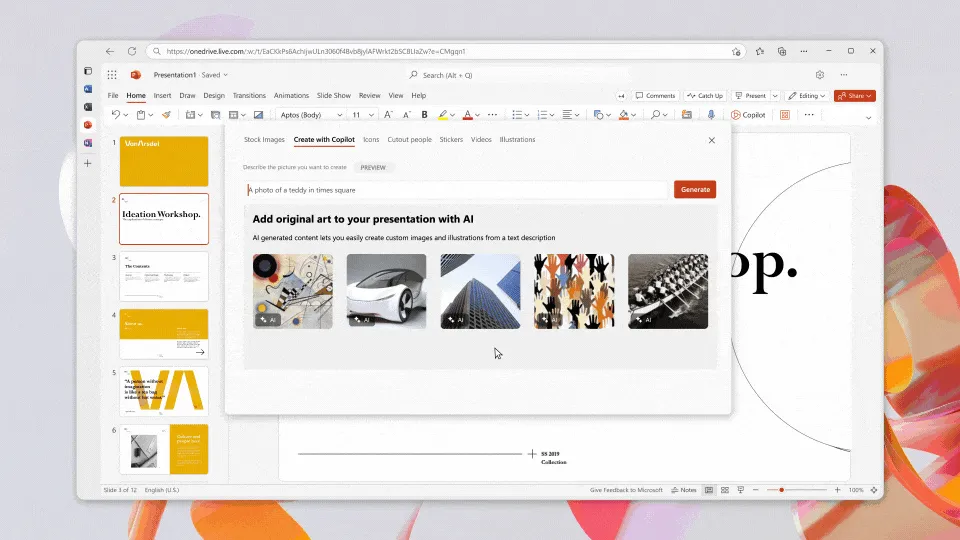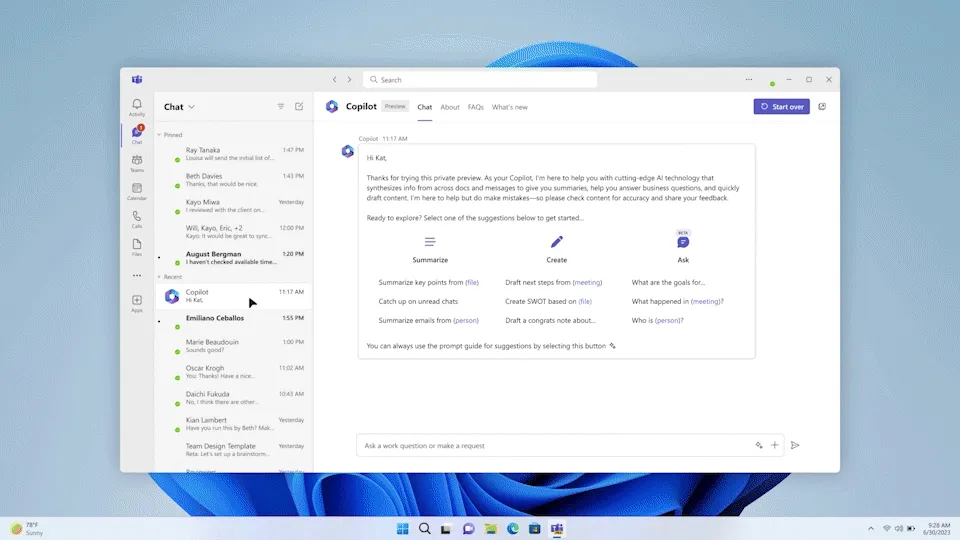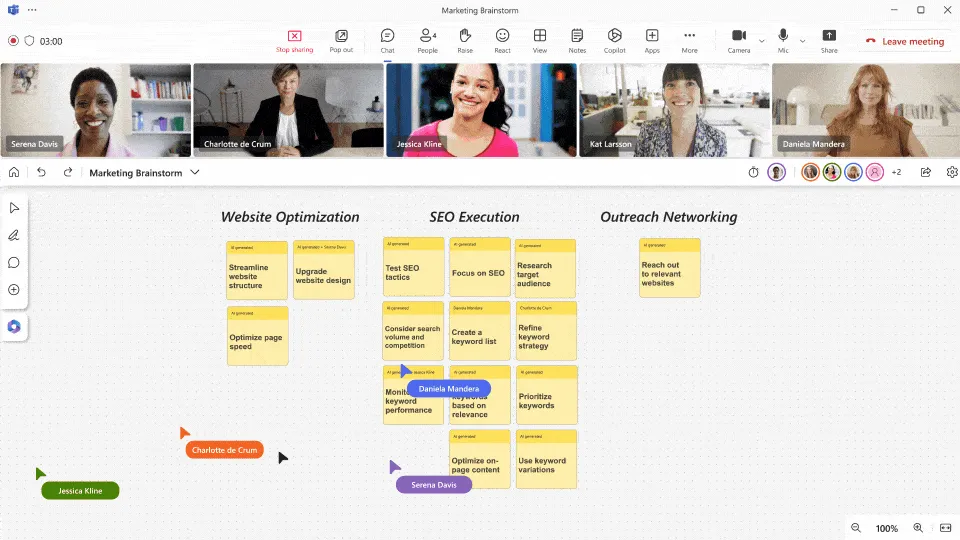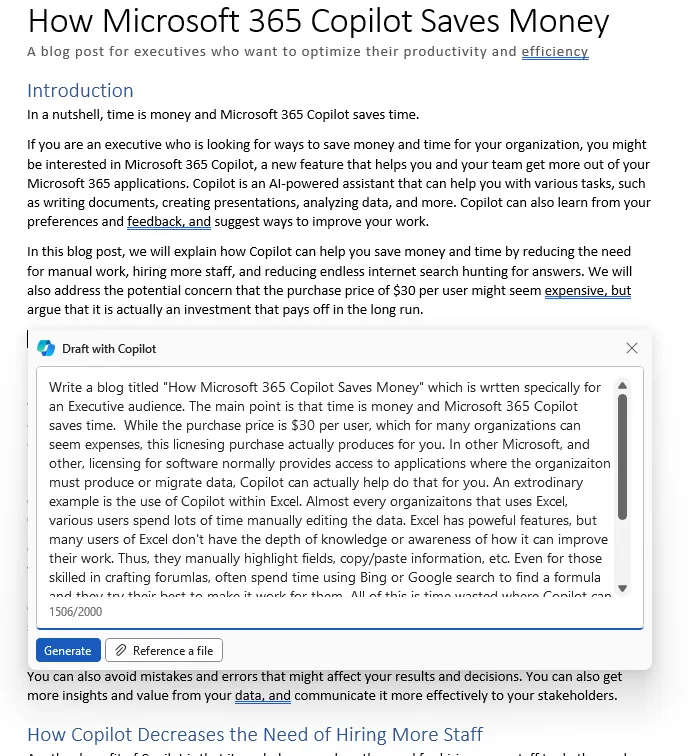How Microsoft 365 Copilot Saves Money
Discover how Microsoft 365 Copilot can revolutionize your workflow, reducing manual tasks and the need for additional staffing, ultimately saving your organization valuable time and money while enhancing productivity

A blog post for executives who want to optimize their productivity and efficiency
Introduction
In a nutshell, time is money and Microsoft 365 Copilot saves time.
If you are an executive who is looking for ways to save money and time for your organization, you might be interested in Microsoft 365 Copilot, a new feature that helps you and your team get more out of your Microsoft 365 applications. Copilot is an AI-powered assistant that can help you with various tasks, such as writing documents, creating presentations, analyzing data, and more. Copilot can also learn from your preferences and feedback, and suggest ways to improve your work.
In this blog post, we will explain how Copilot can help you save money and time by reducing the need for manual work, hiring more staff, and reducing endless internet search hunting for answers. We will also address the potential concern that the purchase price of $30 per user might seem expensive, but argue that it is actually an investment that pays off in the long run.
How Copilot Reduces Manual Work and Provides New Insights
One of the main benefits of Copilot is that it can help you reduce the amount of manual work that you and your team have to do. For example, Copilot can help you with Excel, one of the most widely used applications in Microsoft 365. Almost every organization that uses Excel, various users spend lots of time manually editing the data. Excel has powerful features, but many users of Excel don’t have the depth of knowledge or awareness of how it can improve their work. Thus, they manually highlight fields, copy/paste information, etc. Even for those skilled in crafting formulas, often spend time using Bing or Google search to find a formula and they try their best to make it work for them.

Copilot can help you with all these tasks and more. Copilot can analyze your data and suggest the best way to present it, such as charts, tables, or pivot tables. Copilot can also generate formulas for you based on your data and your goals, such as calculating averages, sums, or percentages. Copilot can also check your formulas for errors and suggest ways to fix them. Copilot can even create natural language summaries of your data, such as “Sales increased by 15% in Q3 compared to Q2”.

By using Copilot, you can save a lot of time and effort that you would otherwise spend on manual work. You can also avoid mistakes and errors that might affect your results and decisions. You can also get more insights and value from your data, and communicate it more effectively to your stakeholders.
How Copilot Decreases the Need of Hiring More Staff
Another benefit of Copilot is that it can help you reduce the need for hiring more staff to do the work that Copilot can do for you. For example, if you have a large amount of data that you need to analyze and report on, you might think that you need to hire more analysts, data scientists, or consultants to help you with that. However, with Copilot, you can do most of the work yourself, or delegate it to your existing team members, who can use Copilot as a tool to enhance their skills and capabilities.

Copilot can help you with not only Excel, but also other Microsoft 365 applications, such as Word, PowerPoint, Outlook, and Teams. Copilot can help you write documents, create presentations, compose emails, and collaborate with your team. Copilot can also help you with tasks that are specific to your industry or domain, such as legal, financial, or marketing. Copilot can learn from your previous work and your feedback, and suggest ways to improve your content, style, and tone.

By using Copilot, you can save money and resources that you would otherwise spend on hiring more staff. You can also empower your existing staff to do more with less, and improve their productivity and efficiency. You can also ensure that your work is consistent and high-quality, and meets your standards and expectations.
How Copilot Pays Off in the Long Run
Some executives might be concerned that the purchase price of $30 per user for Copilot might seem expensive, especially if they have a large number of users in their organization. However, we argue that Copilot is actually an investment that pays off in the long run, and that the benefits outweigh the costs.
- You save money and time that you would otherwise spend on manual work, hiring more staff, or searching for formulas online. As we have shown, Copilot can help you with various tasks in Microsoft 365 applications, and help you get more out of your data and your work. Copilot can also help you avoid errors and mistakes that might cost you money and reputation. Copilot can also help you generate more value and insights from your work, and communicate it more effectively to your stakeholders.
- Your competitive advantage and your innovation get a boost. Copilot can help you stay ahead of the curve and the market, by providing you with the latest and best features and solutions for your work. Copilot can also help you discover new opportunities and possibilities, by suggesting new ways to use your data and your work. Copilot can also help you foster a culture of learning and improvement, by providing you with feedback and suggestions to enhance your work.
- Your satisfaction and engagement improves. Copilot can help you enjoy your work more, by reducing the frustration and boredom that comes from manual work. Copilot can also help you achieve your goals more, by providing you with the tools and the support that you need. Copilot can also help you grow your skills and your confidence, by helping you learn new things and improve your work.
Realize ROI with Change Management
However, buying the license for Copilot is not enough to realize its full potential and benefits. You also need to ensure that your users are aware of Copilot, understand how to use it, and are motivated to adopt it in their daily work. This is where change management comes in. Change management is the process of planning, implementing, and sustaining changes in an organization. Change management can help you increase the adoption and usage of Copilot, and maximize its return on investment (ROI).
Change management for Copilot involves four main steps:
-
Assess: You need to assess your current situation and readiness for Copilot. You need to identify your key stakeholders, your user segments, your communication channels, and your success metrics. You also need to assess the potential risks and challenges that might hinder the adoption of Copilot.
-
Plan: You need to plan your strategy and approach for Copilot. You need to define your vision and goals for Copilot, and align them with your organizational objectives and culture. You also need to design your communication and training plans, and allocate your resources and budget.
-
Implement: You need to implement your plans and actions for Copilot. You need to communicate the value and benefits of Copilot to your users, and provide them with the necessary support and guidance. You also need to train your users on how to use Copilot, and provide them with inspiring examples and best practices.
-
Sustain: You need to sustain the adoption and usage of Copilot. You need to monitor and measure the progress and impact of Copilot, and adjust your plans and actions as needed. You also need to celebrate and recognize the achievements and successes of your users, and solicit their feedback and suggestions for improvement.
By following these steps, you can ensure that your users are not only aware of Copilot, but also engaged and empowered by it. You can also ensure that Copilot becomes part of your organizational culture and practice, and that it delivers the desired outcomes and value for your organization.
Your data is safe, but only if you’ve made it that way
Microsoft 365 Copilot has been engineered to easily use your own organization’s information as you want to use it. However, this also means that you need to be careful and responsible about how you manage and protect your data. If your organization has not purchased or fully used the Microsoft capabilities for security, data loss prevention, compliance, etc., then there could be unintended consequences. For example, you could accidentally expose sensitive or confidential information, violate regulatory or legal requirements, or compromise the integrity or availability of your data.
If your organization has purchased and implemented the Microsoft capabilities for security, data loss prevention, compliance, etc., then you can rest assured that your data is safe and secure. You can also benefit from the enhanced features and functionalities of Microsoft 365 Copilot, such as data governance, encryption, auditing, and retention policies. You can also control and customize how Microsoft 365 Copilot accesses and uses your data, and set your own preferences and policies.
If you are not sure whether your organization has purchased and implemented the Microsoft capabilities for security, data loss prevention, compliance, etc., then you should assume that you have not. You should also take immediate steps to verify and improve your data security and compliance posture. While aligned with a Microsoft 365 Copilot Workshop delivered by Agile IT, you should do this anyway. There is a focus to explain this and an assessment to ensure your files and data are in the state you intend and/or require them to be.
Just in case you’re interested…
I started this blog post with Microsoft 365 Copilot!






